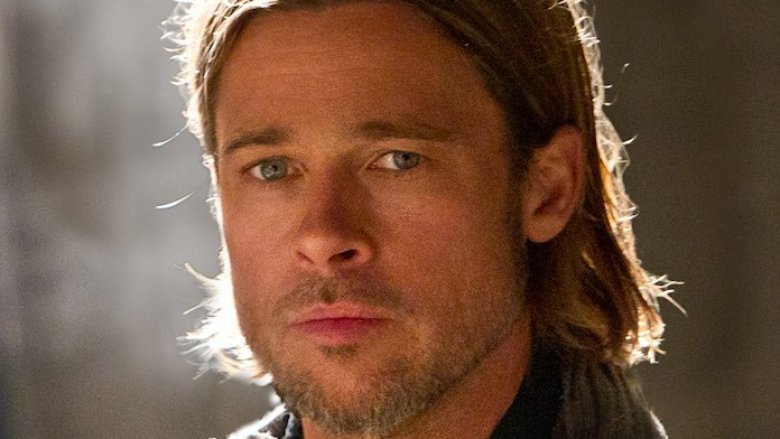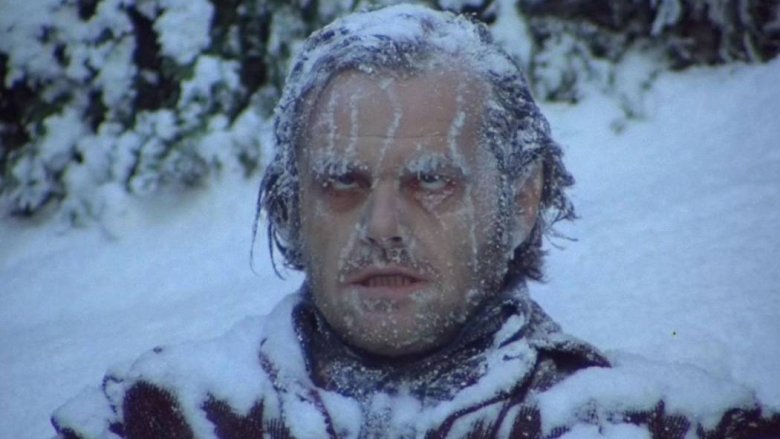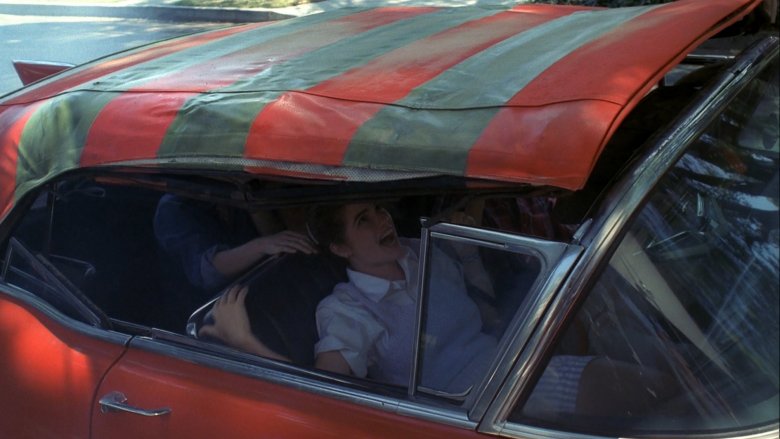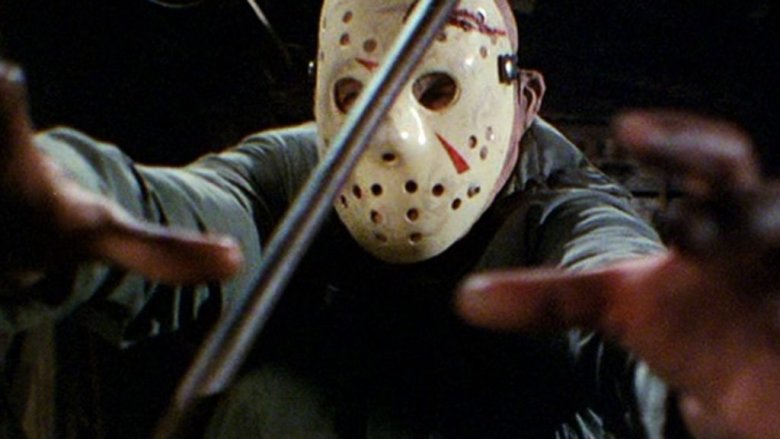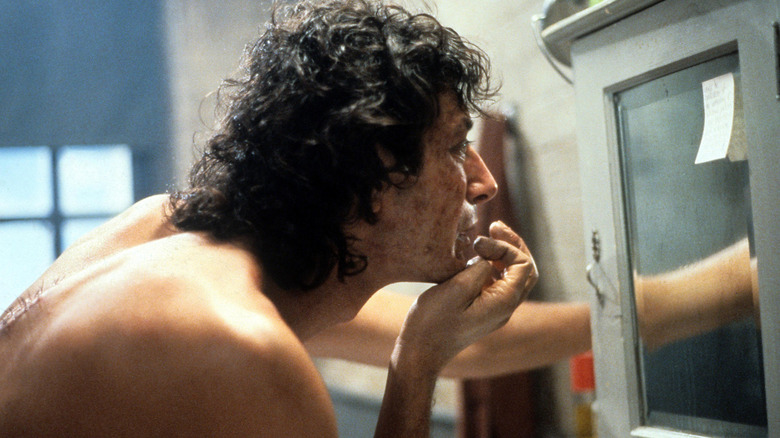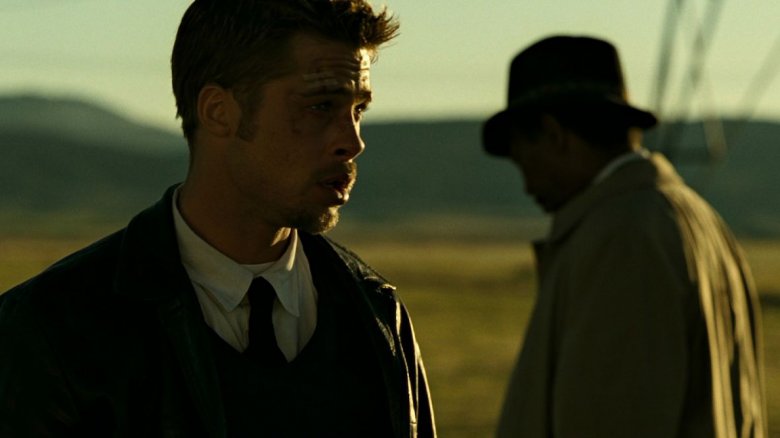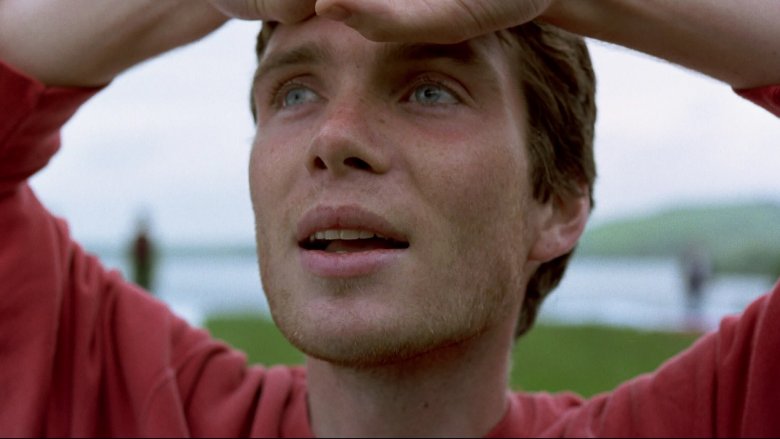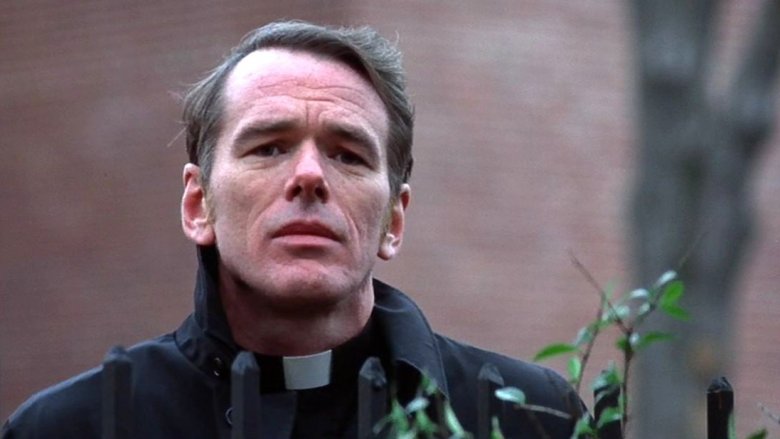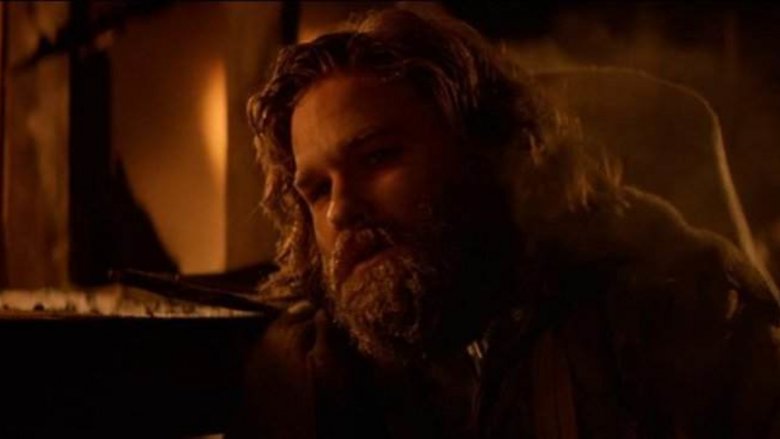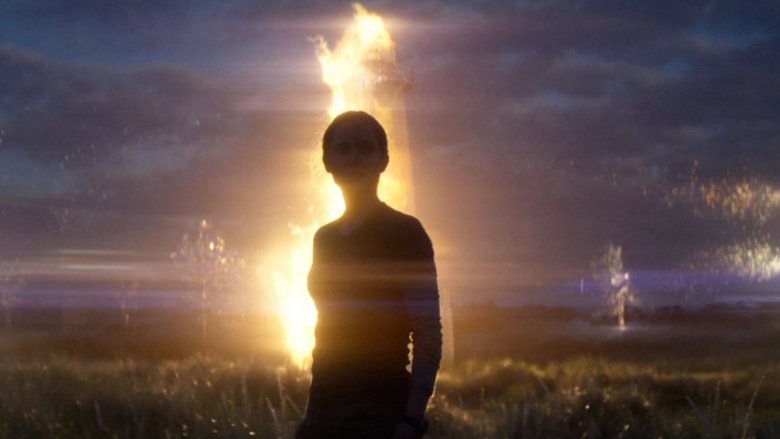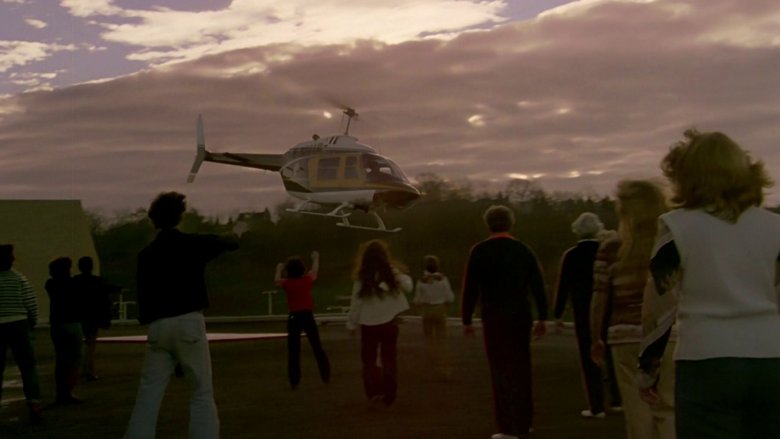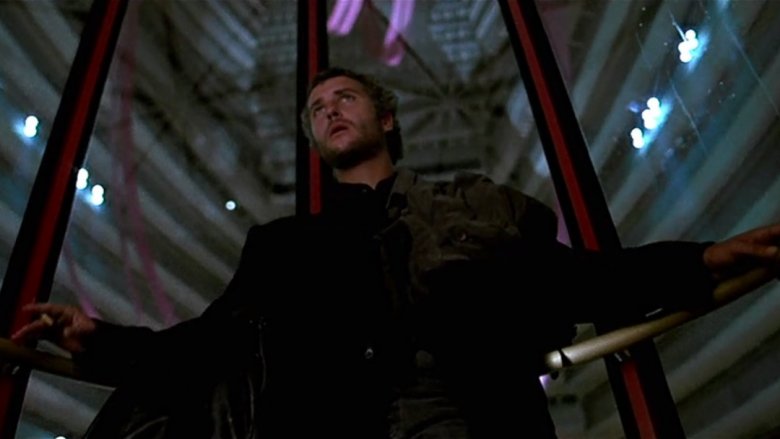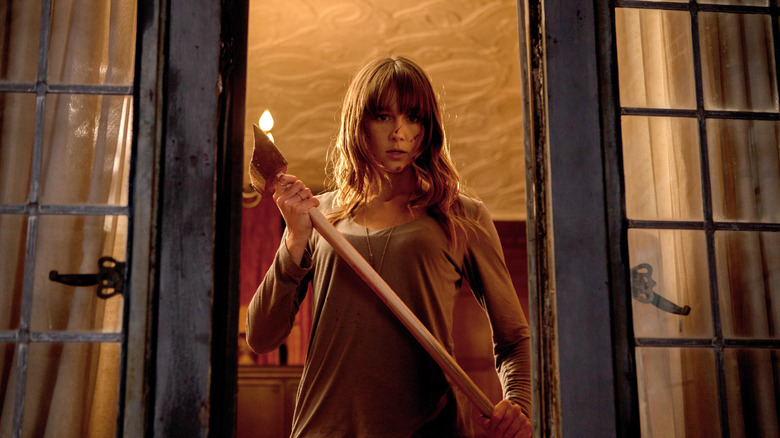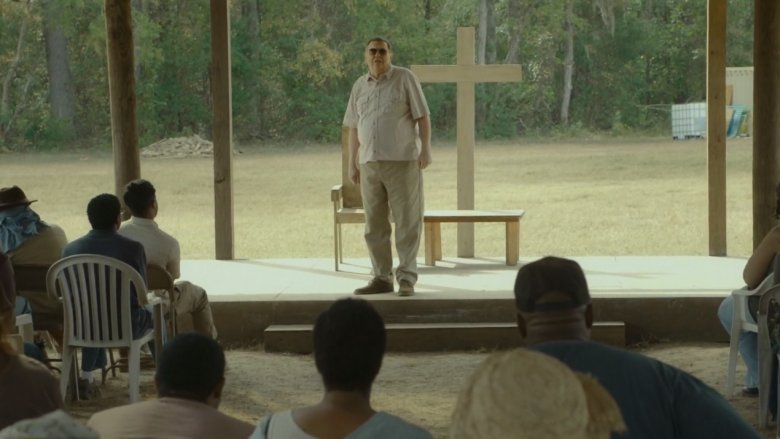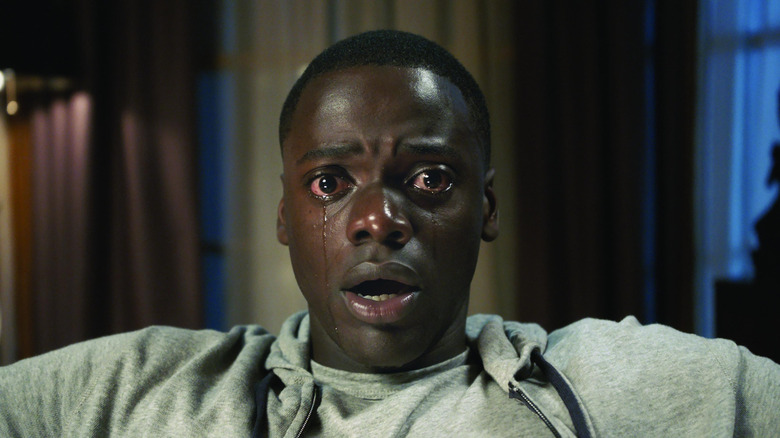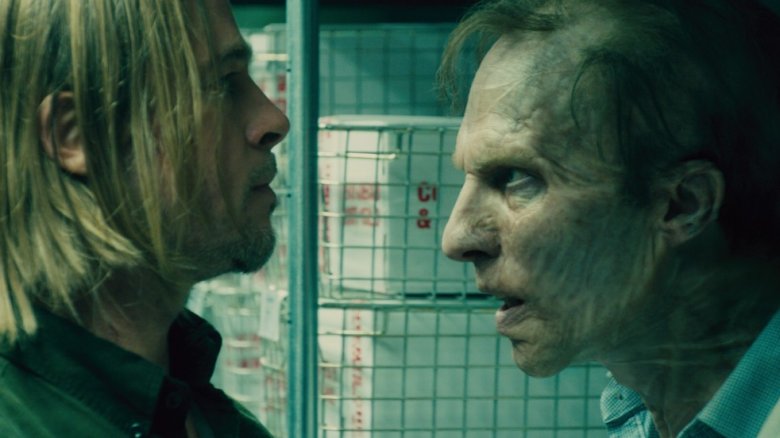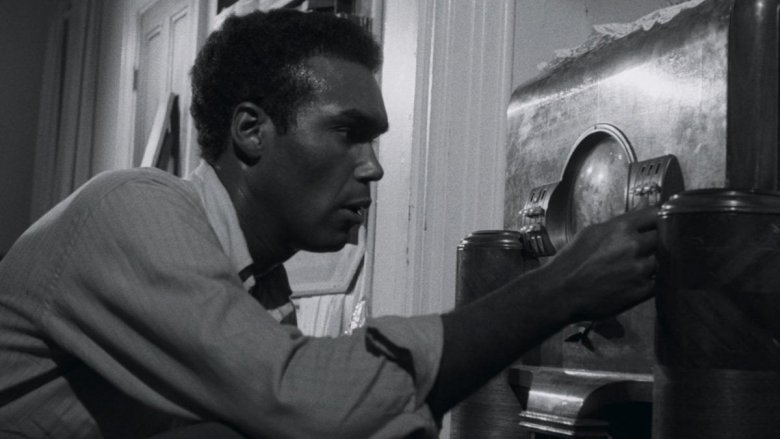Secret Horror Movie Endings You Never Knew Existed
A great ending can make or break a movie. That's especially true for horror films. Of course, finding just the right conclusion can be tricky. Does the final girl get away? Or does the machete-wielding monster chop her head off? In the search for that magic denouement, filmmakers often go through a lot of alternate endings. Perhaps these moments show up in early versions of the screenplay, or maybe the director shot multiple scenes to see what worked the best. However they might exist, these scenes shed new light on awesome films and open up all sorts of possibilities about what might've been. From happy outcomes that were cut to scenes that were slightly less ambiguous, these are alternate horror movie endings you never knew existed. (And be warned, there are plenty of spoilers ahead.)
The Shining had a ball with its ending
The Shining might have the most analyzed ending of any movie ever. After the murderous Jack Torrance (Jack Nicholson) freezes to death outside the Overlook Hotel, he somehow appears in a creepy black-and-white photo from the 1920s. Endings don't get any more ambiguous than this, and with an old jazz song playing over the soundtrack, the final shots of a smiling Jack will haunt you long after the credits roll.
But while the photograph was always part of the ending, Stanley Kubrick considered quite a few scenes that would've made the final moments incredibly different. In one version, Wendy (Shelley Duvall) manages to kill Jack, and that's when the hotel possesses the heroic Mr. Halloran (Scatman Crothers), turning him into the film's big bad. That scene never made it out of an early treatment, but Kubrick did film an additional scene that showed what happened to Wendy and Danny Torrance (Danny Lloyd) after escaping the Overlook's evil influence.
According to Entertainment Weekly, in this deleted sequence, Wendy and Danny wind up at a hospital, where they're greeted by Ullman (Barry Nelson), the hotel manager from earlier in the film. That's when Ullman drops a bombshell: he can't find anything to support Wendy's story. No ghosts, no bloody elevator, nothing. Was it all just in her mind? That's when the ominous Ullman hands Danny the same exact ball that freaked the kid out earlier in the film. So is Ullman part of the Overlook's supernatural plot? Nobody knows for sure, and the scene caused such confusion among early viewers that Kubrick cut it out and had the footage destroyed.
A Nightmare on Elm Street was all just a dream
You can never stop a slasher villain. That's especially true for Freddy Krueger, the sweater-wearing killer who literally haunts your dreams. At the end of A Nightmare on Elm Street, it certainly seems like Nancy (Heather Langenkamp) has defeated Freddy. After turning her back on the monster, he disappears, and life is suddenly back to normal. All of Freddy's victims are alive again, and the future seems bright... until Nancy is trapped in a possessed car and her mom is yanked through an impossibly small window. The nightmare never ended, and Freddy is ready to kill even more kids in part two.
However, director Wes Craven originally intended to give Nancy a happy ending. After turning her back on the bogeyman, Nancy was supposed to wake up and realize everything was just a bad dream. There was no Freddy, her friends and family were all okay, and she'd learned to conquer her fears. However, Robert Shaye wasn't having any of that. As the head of New Line Cinema — the film's production and distribution company — Shaye knew a Nightmare franchise could make big bucks, so he convinced Craven to come up with a new ending. The director shot four different finales, and in the end, the filmmakers decided to go with the darkest one possible, all so Freddy could come back and make a killing at the box office.
Friday the 13th Part III didn't end well for the final girl
Friday the 13th Part III is the film that gave Jason Voorhees his iconic hockey mask and reinforced the lumbering butcher as a bad guy who just won't die. In the film's final showdown at Crystal Lake, the slasher is chasing after final girl Chris Higgins (Dana Kimmell), who's doing everything in her power to escape. She stabs him in the leg, bashes him with a shovel, and hangs him outside a barn before finally planting an ax in Jason's head. And even then, she can't escape a creepy dream sequence where she's dragged underwater by Jason's undead mom. When she finally wakes up, she's absolutely traumatized, and chances are good she'll be dealing with some PTSD for quite a while.
Still, that's a pretty uplifting finale compared to the alternate ending. Similar to the theatrical version, this finds Chris crawling into a canoe and paddling out into Crystal Lake. Eventually, she returns to shore and makes her way back to the abandoned vacation house where Jason massacred all her friends. She hears a noise inside and, thinking it's her boyfriend, runs to the door. But the course of true love never did run smooth, especially when there are psycho killers involved. The door swings open, and there's Jason. This time, there's no escape for Chris. Jason grabs her by the hair and lops off her head with a blow from his machete. Sure, the theatrical ending is pretty grim, but it's way better to have Jason in your head than for Jason to be walking around with your head.
The Fly had a bizarre butterfly baby
When it comes to downbeat endings, it doesn't get any grimmer than The Fly. After turning into a hideous insect creature, Seth Brundle (Jeff Goldblum) starts losing his mind. Desperate to restore his humanity, he plans to genetically merge with his girlfriend Veronica Quaife (Geena Davis) and their unborn baby. He hopes the three can morph into a brand new creature, and naturally, Veronica isn't crazy about this plan. But after a gross, gooey showdown leaves Seth even more deformed, a traumatized Veronica puts him out of his misery with a shotgun blast to the head.
And that's where the film ends, with Veronica weeping over Seth's mangled, mutated body. On top of all that, we're still really worried about her unborn baby. After all, Seth is the dad, and Veronica fears her kid might be part fly. She's so freaked out that she's having dreams where she gives birth to a maggot. It's pretty dark stuff, but in fairness, director David Cronenberg did shoot four alternate endings, including a happy one where Veronica gives birth to a perfectly normal child.
Perhaps the strangest possible ending is yet another dream sequence. Only this time, Veronica envisions her child as a butterfly baby, complete with angelic insect wings. But after considering all the possible outcomes, Cronenberg realized Seth's death was so traumatic that no ending was going to make things okay, so he decided to stick with the nihilistic finale. And honestly, that's probably for the best, because even though the butterfly baby is supposed to be beautiful, the design is almost as creepy as the Brundlefly itself.
Seven was squeamish about its ending
"What's in the box?" That iconic line from David Fincher's Seven has become part of the pop culture consciousness because we all know what's in that box. Taking inspiration from the seven deadly sins, serial killer John Doe (Kevin Spacey) has decapitated Tracy, the wife (Gwyneth Paltrow) of Detective Mills (Brad Pitt), and placed her head inside a package. Despite the pleas of Detective Somerset (Morgan Freeman), Mills grows so enraged that he gives way to the seventh deadly sin — wrath — and puts a bullet in John Doe's head.
It's a truly disturbing ending, one that cemented Seven's status as one of the all-time great horror films. But studio executives were incredibly squeamish about these final few moments, worrying that if you decapitated Gwyneth Paltrow, put her head in a box, and then have Brad Pitt fall into the bad guy's trap, disgusted audiences might stay away from theaters. So the studio brass did their best to get Fincher to change the ending. They considered a version of the film in which Somerset kills John Doe, thus foiling the killer's plans, and there's another version showing Doe murdering Mills before getting shot by Somerset.
In one of the more ridiculous alternate versions, the studio wanted Mills and Somerset to save Tracy before Doe cut her head off. According to Pitt, the producers were so worried about the ending that they actually considered putting a dog's head in the box. But ultimately, Fincher and the actors refused to bend, although the director did acquiesce a little by putting the Ernest Hemingway quote at the end. In true depressing Fincher fashion, he originally wanted the film to go black right after Mills gave way to wrath.
28 Days Later was undead and downbeat
Directed by Danny Boyle, 28 Days Later helped resurrect the zombie genre by giving us rage viruses and incredibly fast creatures. But for all the carnage and cannibalism, the movie ends on a oddly hopeful note, with the three leads — Jim (Cillian Murphy), Selena (Naomie Harris), and Hannah (Megan Burns) — escaping both the zombies and a bunch of rapists before they're discovered by a passing plane.
However, there are multiple alternate endings where Jim isn't so lucky. In two different endings that more or less play out in the same fashion, after Jim is shot, Selena and Hannah rush him to a hospital and desperately try to save his life. Sadly, they can't bring him back, and the two women slowly walk away, leaving Jim's body lying in a hospital bed in a nice little bookend with the beginning of the film.
In a third alternate ending, it goes almost the exact same way as the original, but without a doubt, the fourth ending is the craziest, as it completely drops the whole rapist-soldier section. Instead, this finale involves Jim giving a complete blood transfusion to save Hannah's infected father, Frank (Brendan Gleeson). Either way, out of the five endings considered, Jim only made it out of one alive.
The Exorcist turns into a meet-cute
A horror milestone, The Exorcist has scared countless moviegoers since 1973, but you've got to wonder if the original ending would've dulled the film's head-spinning impact. In the version that hit theaters, young Regan MacNeil (Linda Blair) is packing her bags and about to leave her house of horrors when she's gifted an amulet by the kindly Father Dyer (Father William O'Malley), the only priest who gets out of this movie alive. As Regan and her mother drive away, Father Dyer watches their car disappear into the distance, and that's when those eerie tubular bells start chiming.
Sure, Regan is okay now, but there's a slightly ominous feel as the credits start rolling, leaving films fans to mull over the nightmare they just witnessed. However, director William Friedkin originally ended the movie on a much more upbeat note. In this alternate version, Father Dyer watches Regan drive away and then runs into Detective Kinderman (Lee J. Cobb). The two strike up a friendship, start cracking jokes, and then Kinderman invites Father Dyer to see a movie with him. Stranger still, as the two walk down the road together, the detective quotes an iconic line from Casablanca: "I think this is the beginning of a beautiful friendship."
Fortunately, Friedkin cut this scene due to time constraints, but Exorcist author William Peter Blatty thought it left audiences feeling more hopeful. Years later, Friedkin came to agree with Blatty's POV, and in the director's cut of the film, Friedkin put the meet-cute back in, minus the Casablanca line. Of course, not everyone was happy with this cheerful finale, including film critic Roger Ebert who described it as "a guest who keeps talking after the party is over."
The Thing was way less ambiguous
Directed by John Carpenter, The Thing features one of the all-time great ambiguous endings. After defeating an alien shapeshifter, helicopter pilot R.J. MacReady (Kurt Russell) sits down in the fiery ruins of an Antarctic base. At first, it seems like he's the last surviving member of US Outpost 31, but that's when his frenemy, Childs (Keith David), comes wondering out of the snow. MacReady suspects that Childs might be a "thing," and Childs has the same suspicions about his old rival. So the two sit there in the snow, waiting each other out, and we never know for sure who's human, who's not, or if they both freeze to death out there in the ice.
It's the perfect paranoid ending, but there were a couple of alternates that might've ruined The Thing's mysterious mystique. In one version, the film ends with that creepy dog — the same one from the beginning — running into the distance and leaving the smoking base behind, implying the Thing will definitely strike again. Carpenter was also talked into shooting a happy ending in case they had to toss the ambiguous version later on. In this scene, MacReady is rescued and given a blood test to prove that he's human. Thankfully for horror fans everywhere, this version has never seen the light of day.
Annihilation brought the Shimmer back
Based on the novel by Jeff VanderMeer, Annihilation finds Natalie Portman as a cellular biologist heading into the Shimmer, an ever-growing nightmare realm of slithering intestines and mutated skull bears. Thankfully, Portman's character eventually burns the Shimmer down and reunites with her long-lost husband... sort of. As it turns out, her real husband (Oscar Isaac) died inside the Shimmer, and he's been replaced by a doppelgänger. And honestly, we're not 100 percent sure Portman isn't some sort of alien clone either. All we know is that when they embrace, we can see shimmering lights in their eyes, implying the Shimmer is still very much alive inside their DNA.
It's a mysterious little ending that leaves us wondering about the fate of the world, but in the original script by Alex Garland, things were far less ambiguous. After the two give each other a hug, the film cut to a meteor shower, only these aren't your typical space rocks: When one of the meteorites hits the Earth, it cracks open, and we get a look inside and see a lot of shimmering. Evidently, these meteors are carrying new strains of the Shimmer, and the world is about to undergo some massively creepy renovations. But for whatever reason — possibly to keep that ending enigmatic — Garland chopped out the alien invasion-by-meteorite, leaving us to debate whether Portman actually made it out.
Dawn of the Dead was a lot darker
Zombie movies rarely ever have happy endings, so as far as films about undead monsters go, Dawn of the Dead is downright cheerful. At the end of this 1978 shopping mall massacre, just two of the heroes — Peter (Ken Foree) and Francine (Gaylen Ross) — survive, making their way to the roof and escaping via helicopter. Sure, there's no guarantee what will happen when they land, but as for now, they're in one piece up where no zombie can't reach them.
However, in George Romero's original script, things got a lot messier. Realizing there's no escaping the oncoming horde, Peter shoots himself offscreen, leaving Francine alone. The helicopter is running, and knowing it's only a matter of time before she becomes zombie food, she sticks her head in the blades. Adding insult to injury, after Francine gets decapitated, the helicopter runs out of gas. So even if Peter and Francine had gotten to the chopper, they wouldn't have gotten far before winding up in a twisted pile of metal and flame.
According to Little White Lies, Romero changed the ending after realizing the movie had a more lighthearted, silly feel than Night of the Living Dead (yes, "lighthearted" is relative, but Night is about as dark as zombie movies get). Plus, Romero just really liked the characters and didn't want them to end up as dinner.
Manhunter gets close to the darkness
Michael Mann's Manhunter was the first film to bring Hannibal Lecter to the big screen, and it was also the first time moviegoers met Will Graham. Played by William Petersen, Graham is a legendary forensic profiler, a man so empathetic that he basically becomes the killers he's trying to catch. And that's what helps him track down Francis Dolarhyde (Tom Noonan), a man who butchers entire families. But that extreme empathy also causes Graham to stare a little too long into the abyss, the one that turns you into a monster if you're not careful.
There's a deleted scene in Manhunter that truly shows Graham's troubled psyche, and if it hadn't been cut, it would have been the second to last scene in the movie. After catching Dolarhyde (and getting his face scarred up in the process), Graham visits the next family the so-called "Tooth Fairy" was preparing to kill. He shows up at their doorstep, and when the family learns this is the man who saved their lives, they invite him in. Graham hesitates — wrestling with the demons that connect him with Dolarhyde — before saying he just dropped by to see them. He then turns and walks away in slow motion, and it's a powerful moment that shows while Graham has touched the darkness, he's back on the slow road to recovery.
You're Next didn't end well for poor Erin
You're Next is a gory home invasion flick that ends with blood and brains splattered on the walls. The movie follows a seemingly normal woman named Erin (Sharni Vinson) who's going to meet her boyfriend's well-to-do family. The entire clan is hanging out at their secluded vacation home, but the reunion is ruined when three masked killers show up to pick everybody off.
Needless to say, pretty much every member of this upper class dinner party is worthless when it comes to life-or-death scenarios... except Erin. As it turns out, she was raised in a survivalist compound, and she uses her unique skills to build booby traps and fight off the animal-themed murderers. In fact, she's just as deadly as the bad guys, and when she figures out her boyfriend hired these masked mercenaries to kill his family as part of an inheritance scheme, she introduces his eyeball to a screwdriver.
And that's when a cop shows up, sees all the dead bodies, and puts a bullet in Erin's shoulder. It's an understandable mistake, but unfortunately for Mr. Policeman, he doesn't know there's a booby trap right above the front door. Despite Erin's cries to stay away, he opens the door and gets a nasty surprise. It's a darkly comic ending to a fantastically bloody film, but the movie almost ended on a far darker note. Both actress Vinson and director Adam Wingard confirmed on Twitter that originally, the cop was supposed to shoot Erin in the head. They even filmed Erin's death scene, but fortunately, Wingard decided to spare Erin her unfortunate fate.
The Sacrament had an even bigger body count
If you know anything about the real-life Jonestown massacre, then you know The Sacrament isn't going to end well. Directed by Ti West, this found-footage horror movie follows a group of Vice reporters who venture into a secluded forest to do a story on a utopian cult led by the charismatic "Father" (Gene Jones of No Country for Old Men). At first, it seems like the cult is living that easygoing, communal lifestyle, but it turns out Father is a psychopathic preacher who plans on murdering everyone in his compound.
Taking a page from the Jim Jones playbook, Father has all his followers drink poison-laced juice, and we watch in horror as they cry out, convulse, and foam at the mouth. Soon, the compound is full of dead bodies, and only two of the journalists manage to escape, boarding a helicopter and leaving the carnage behind. However, in the original script, there was supposed to be a last-minute twist where the helicopter pilot was secretly a cult member and, in dedication to Father, crashes the chopper, killing everyone aboard. West decided this was just "too nihilistic"; plus, the folks who actually run Vice didn't want to be involved in a film where Vice reporters are violently murdered, so he obliged.
Get Out got a lot worse for Chris
Directed by Jordan Peele, Get Out has one of the greatest horror endings of the 21st century. After nearly getting his brain replaced, Chris Washington (Daniel Kaluuya) escapes his bonds and murders most of the psychotic Armitage family. He's in the process of choking his ex-girlfriend (Allison Williams) when he sees some flashing red and blue lights. Naturally, we assume a racist cop is about to blast Chris to kingdom come, but fortunately, it's his friend, TSA Agent Rod Williams (Lil Rel Howery).
By this point, it's pretty well known that Peele was considering an ending where instead of Rod showing up, it actually was the police, and things wouldn't work out so well for poor Chris. But there was a third ending, one that owes a lot to the 1975 horror classic The Stepford Wives. In one version of the screenplay, the story is set in a gated community, and the movie ends with Rod showing up, looking for Chris. He finds his buddy staring at a reflection in a window, and as Peele explained to The Hollywood Reporter, "[Rod] goes 'Chris, I've been looking for you. Are you okay?' And Chris turns to him and goes, 'I assure you, I don't know who you're talking about.'"
That's right — in one version of the script, Chris gets his brain scooped out, and he's turned into an elderly white person, just like poor Lakeith Stanfield's character. Thankfully, Peele went with the feel-good option, the perfect finale in a world where we rarely get happy endings to stories like these.
World War Z went in a wildly different direction
Based on the novel by Max Brooks, World War Z was plagued with behind-the-scenes drama that forced filmmakers to completely rewrite the ending. As it currently stands, the film has former UN worker Gerry Lane (Brad Pitt) discovering that zombies aren't interested in people infected with terminal illnesses. This discovery allows humans to gain the upper hand against the undead threat, and it's considerably more upbeat than what the filmmakers originally had in store.
In the ending that never made it to theaters, Gerry Lane winds up in Russia, where his cell phone is stolen, and he's conscripted into the Russian army. He basically becomes a zombie-killing Rambo, complete with a specialized shovel weapon. During his battles, he learns the undead have a big problem with the cold, and that's the secret that starts turning the tide against the zombie horde.
However, that doesn't mean things get any easier for poor Gerry. Eventually, he gets his cell phone back, calls his wife (Mireille Enos), and discovers she's living in a refugee camp in the Everglades. Unfortunately, this is a pretty rough place, and in order to survive, she's forced to sleep with a twisted soldier played by Matthew Fox. This doesn't sit well with Gerry, and he heads back to America, planning to rescue his wife. So if you're wondering why Jack from Lost only shows up for a few seconds in the theatrical version, it's because he originally had a bigger part to play.
Night of the Living Dead had a way happier ending
Directed by George Romero, Night of the Living Dead is the gory granddaddy of the modern-day zombie. This 1968 classic was also a major influence on Get Out director Jordan Peele, who considers the film a milestone in the history of African-American horror. After all, the lead character is a black man who survives a horde of undead cannibals, only to be gunned down by a white mob. The lead hero was originally envisioned as a white man, but when actor Duane Jones auditioned for the role of Ben, Romero knew he was perfect for the part.
Aside from giving a fantastic performance, Jones also saved it from screwing up its ending. According to Jones, Romero was actually thinking about having Ben live to fight another day, but the actor knew the happy ending wasn't going to work. "I convinced George," Jones said, "that the black community would rather see me dead than saved, after all that had gone on, in a corny and symbolically confusing way." And in an era where heroes in American movies rarely died, Jones thought it would be a big deal to have the main character killed off. As he put it, "The jolt of that and the double jolt of the hero figure being black seemed like a double-barreled whammy."
